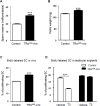Expression of dominant-negative thyroid hormone receptor alpha1 in Leydig and Sertoli cells demonstrates no additional defect compared with expression in Sertoli cells only
- PMID: 25793522
- PMCID: PMC4368620
- DOI: 10.1371/journal.pone.0119392
Expression of dominant-negative thyroid hormone receptor alpha1 in Leydig and Sertoli cells demonstrates no additional defect compared with expression in Sertoli cells only
Abstract
Background: In the testis, thyroid hormone (T3) regulates the number of gametes produced through its action on Sertoli cell proliferation. However, the role of T3 in the regulation of steroidogenesis is still controversial.
Methods: The TRαAMI knock-in allele allows the generation of transgenic mice expressing a dominant-negative TRα1 (thyroid receptor α1) isoform restricted to specific target cells after Cre-loxP recombination. Here, we introduced this mutant allele in both Sertoli and Leydig cells using a novel aromatase-iCre (ARO-iCre) line that expresses Cre recombinase under control of the human Cyp19(IIa)/aromatase promoter.
Findings: We showed that loxP recombination induced by this ARO-iCre is restricted to male and female gonads, and is effective in Sertoli and Leydig cells, but not in germ cells. We compared this model with the previous introduction of TRαAMI specifically in Sertoli cells in order to investigate T3 regulation of steroidogenesis. We demonstrated that TRαAMI-ARO males exhibited increased testis weight, increased sperm reserve in adulthood correlated to an increased proliferative index at P3 in vivo, and a loss of T3-response in vitro. Nevertheless, TRαAMI-ARO males showed normal fertility. This phenotype is similar to TRαAMI-SC males. Importantly, plasma testosterone and luteinizing hormone levels, as well as mRNA levels of steroidogenesis enzymes StAR, Cyp11a1 and Cyp17a1 were not affected in TRαAMI-ARO.
Conclusions/significance: We concluded that the presence of a mutant TRαAMI allele in both Leydig and Sertoli cells does not accentuate the phenotype in comparison with its presence in Sertoli cells only. This suggests that direct T3 regulation of steroidogenesis through TRα1 is moderate in Leydig cells, and that Sertoli cells are the main target of T3 action in the testis.
Conflict of interest statement
Figures





References
-
- Jannini EA, Ulisse S, D'Armiento M (1995) Thyroid hormone and male gonadal function. Endocr Rev 16: 443–459. - PubMed
-
- Choksi NY, Jahnke GD, St Hilaire C, Shelby M (2003) Role of thyroid hormones in human and laboratory animal reproductive health. Birth Defects Res B Dev Reprod Toxicol 68: 479–491. - PubMed
-
- Joyce KL, Porcelli J, Cooke PS (1993) Neonatal goitrogen treatment increases adult testis size and sperm production in the mouse. J Androl 14: 448–455. - PubMed
-
- Cooke PS, Meisami E (1991) Early hypothyroidism in rats causes increased adult testis and reproductive organ size but does not change testosterone levels. Endocrinology 129: 237–243. - PubMed
-
- van Haaster LH, de Jong FH, Docter R, de Rooij DG (1993) High neonatal triiodothyronine levels reduce the period of Sertoli cell proliferation and accelerate tubular lumen formation in the rat testis, and increase serum inhibin levels. Endocrinology 133: 755–760. - PubMed
Publication types
MeSH terms
Substances
LinkOut - more resources
Full Text Sources
Other Literature Sources
Molecular Biology Databases

